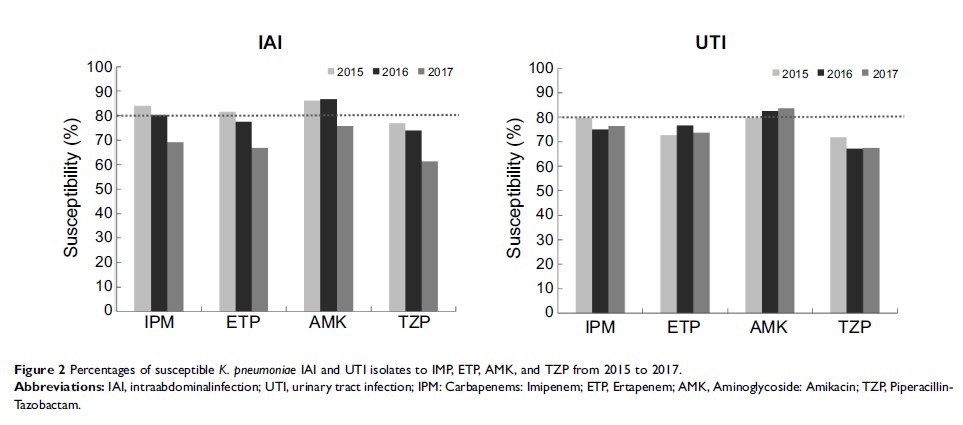9 0 8 1 0
论文已发表
注册即可获取德孚的最新动态
IF 收录期刊
- 2.6 Breast Cancer (Dove Med Press)
- 3.9 Clin Epidemiol
- 3.3 Cancer Manag Res
- 3.9 Infect Drug Resist
- 3.6 Clin Interv Aging
- 4.8 Drug Des Dev Ther
- 2.8 Int J Chronic Obstr
- 8.0 Int J Nanomed
- 2.3 Int J Women's Health
- 3.2 Neuropsych Dis Treat
- 4.0 OncoTargets Ther
- 2.2 Patient Prefer Adher
- 2.8 Ther Clin Risk Manag
- 2.7 J Pain Res
- 3.3 Diabet Metab Synd Ob
- 4.3 Psychol Res Behav Ma
- 3.4 Nat Sci Sleep
- 1.9 Pharmgenomics Pers Med
- 3.5 Risk Manag Healthc Policy
- 4.5 J Inflamm Res
- 2.3 Int J Gen Med
- 4.1 J Hepatocell Carcinoma
- 3.2 J Asthma Allergy
- 2.3 Clin Cosmet Investig Dermatol
- 3.3 J Multidiscip Healthc

来自医院和社区获得的腹腔内和泌尿道感染的革兰氏阴性杆菌的易感性: 2016-2017 中国 SMART 研究的更新
Authors Zhang H, Johnson A, Zhang G, Yang Y, Zhang J, Li D, Duan S, Yang Q, Xu Y
Received 30 January 2019
Accepted for publication 15 March 2019
Published 24 April 2019 Volume 2019:12 Pages 905—914
DOI https://doi.org/10.2147/IDR.S203572
Checked for plagiarism Yes
Review by Single-blind
Peer reviewers approved by Dr Colin Mak
Peer reviewer comments 2
Editor who approved publication: Dr Joachim Wink
Objectives: To update
the epidemiology and susceptibility of hospital-acquired (HA) and
community-acquired (CA), as well as intensive care unit (ICU) vs
non-ICU-derived intra-abdominal infection (IAI) and urinary tract infection
(UTI) pathogens in Chinese hospitals.
Methods: A total
of 2,546 Gram-negative isolates from IAIs and 1,947 isolates from UTIs
collected in 16 hospitals and 7 regions of China from 2016 to 2017 were
analyzed.
Results: E. coli and K. pneumoniae were
the most common pathogens identified in HA (40.7%, 21.9%) and CA (49.2%, 21.3%)
IAIs and in HA (59.0%, 17.3%) and CA (64.3%, 12.7%) UTIs, respectively. The
overall rates of extended-spectrum β-lactamase (ESBL)-positive strains were
48.2% for E.
coli and 26.4% for K. pneumoniae . The rates of ESBL-positive E. coli and K. pneumoniae strains
were significantly higher in HA than in CA IAIs (51.7% vs 42.4%, P =0.016 and 22.0%
vs 20.6%, P <0.001).
IAI E.
coli ESBL-producing isolates were most susceptible to IPM
(97.2%) and AMK (93.9%), and UTI-associated E. coli ESBL-producers
were 94.74% susceptible to amikacin (AMK), 97.02% to imipenem (IPM), and 91.4%
to ertapenem (ETP). IAI K. pneumoniae ESBL-producing isolates were most
susceptible to AMK (84.43%) and IPM (82.79%), and UTI-associated K. pneumoniae ESBL-producers
were 88.39% susceptible to AMK, 87.5% to IPM, and 82.14% to ETP. Overall,
percentages of susceptible strains to ETP, IPM, AMK, and
Piperacillin-Tazobactam (TZP) were in the range of 82.0% to 96.4%, to 5
cephalosporins in the range of 31.4%-69.6% and to 2 fluoroquinolones in the
range of 37.8%-45.5% for E. coli and 65.5%-90.7%, 37.7%-75.3%, and
43.9%-73.2% for K. pneumoniae , respectively.
Conclusion: E. coli and K. pneumoniae continued
to be the main pathogens in Chinese UTIs and IAIs with high ESBL-positive rates
between 2016 and 2017. Carbapenem- or amikacin-based therapies were the most
effective to combat IAI and UTI pathogens.
Keywords: IAI, UTI,
ESBL, E.
coli , K. pneumoniae
